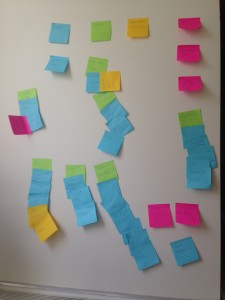This piece originally appeared on the blog of the Tri-Co Digital Humanities Initiative, who have sponsored Brenna Levitin (BMC ’16) as our intern this summer. In addition to the two posts she has published on the Tri-Co DH site, Brenna has published regular updates on this blog. To catch up with her summer work, read her thoughts on a find in the 1989 Alumnae Bulletin, her consideration of silence in the archives, and her approach to using digital tools to address the silence.
When I last wrote, I optimistically assumed that July would be for oral histories and August would be for creating the exhibit. In reality, oral history work has bled over into August, and I’ve actually been building the exhibit since mid-July. I also described the analog/digital split in my project, which has evolved; as August has worn on, I’ve simultaneously handled our first donations of alumnae/i materials (flyers, photos, etc) while drafting the actual pages of the exhibit.
As the first Scalar project undertaken at Bryn Mawr Special Collections, I am conscious of my duty to document the process. Scalar has offered me enormous freedom to design the exhibit in any multi- or non-linear way that I wish. That freedom is not without a price, however; non-linear documentation means that pages can fall through the cracks; technically contained within the exhibit but unlikely to fall within the viewer’s path. Recently, I struggled to decide how to organize the exhibit in a way that would not imply that this history is complete while still showcasing every possible morsel of information that I gathered. Continue reading
